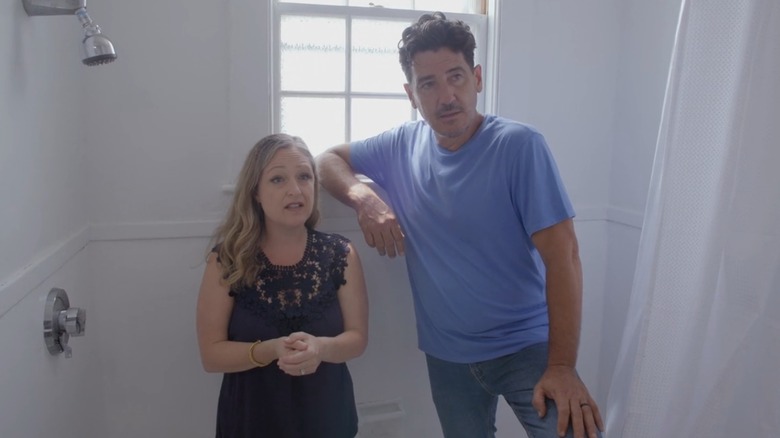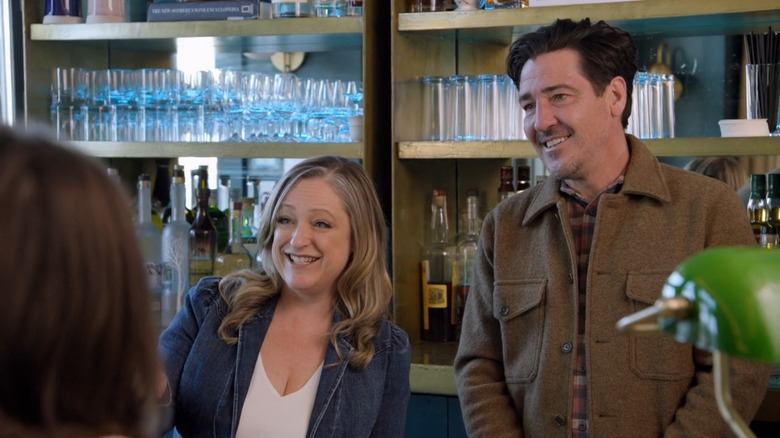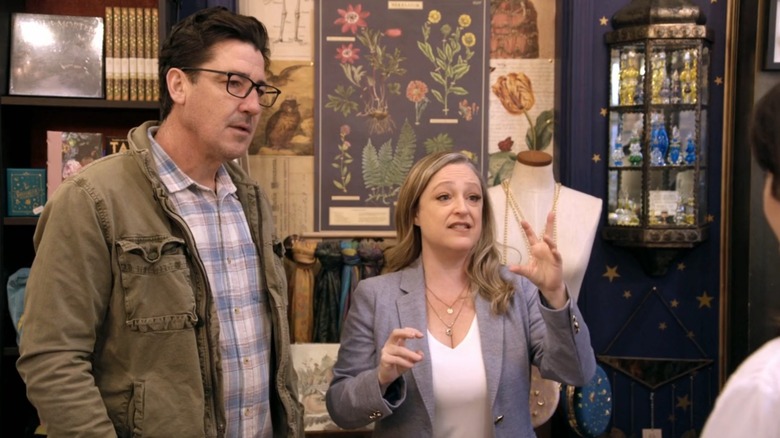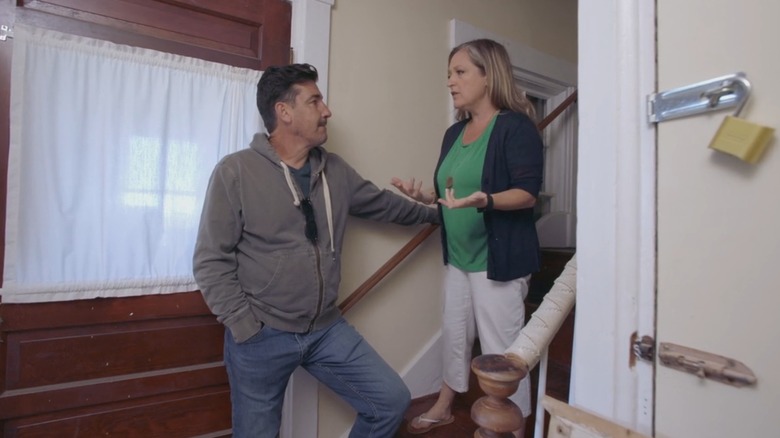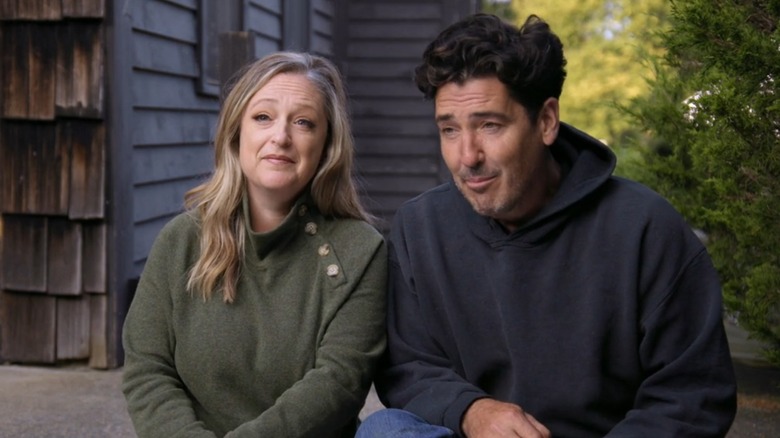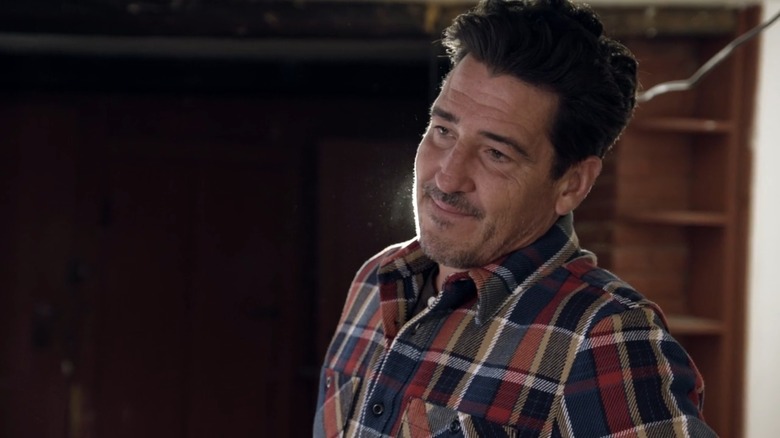What The Cameras Don't Show You On HGTV's Farmhouse Fixer
"Farmhouse Fixer" has become a fan-favorite HGTV show since it debuted in 2021, with the series being headlined by boy band heartthrob turned HGTV host Jonathan Knight and established interior designer Kristina Crestin. The duo works to revitalize the historic New England homes of their clients, staying true to the houses' legacies while adapting the spaces to accommodate homeowners.
Avid viewers of the series know that it features everything from haunted homesteads to sprawling lighthouses, but the truth about "Farmhouse Fixer" is that there's plenty of behind-the-scenes details that the cameras don't capture. For example, when asked about the most challenging part of the show, Crestin mentioned the time constraints and demands of filming, an unexpected detail about being on an HGTV show that contestants know well.
"I would say timeline management was one of the biggest challenges," she told Northshore Magazine. "Filming felt really natural. ... But navigating the timelines—the faster clip, the faster communication—was the biggest challenge, I think." While filming logistics is one element of "Farmhouse Fixer" that viewers don't see, it's far from the only one.
Homeowners need to meet these Farmhouse Fixer requirements
Whether they're vying for a spot of their own or simply curious about the logistics of reality TV, HGTV fans have long wondered how contestants really get on the network's shows. A casting call for Season 2 of "Farmhouse Fixer" provides some insight into what it takes to work with Jonathan Knight and Kristina Crestin, with the requirements being pretty specific.
An advert shared by Northshore Magazine in February 2020 revealed that HGTV and High Noon Entertainment were taking applications for renovation-minded homeowners located within 50 miles of Ipswich, Massachusetts. The show was specifically seeking houses constructed before 1940 that included four to five spaces in need of renovation. If you're thinking a slot on HGTV will pay for your remodels, that isn't the case for "Farmhouse Fixer," with the series requiring homeowners to have a budget of at least $150,000.
Other than this, the ad mentions that clients are expected to pass over creative control to the hosts while also staying off-property for the duration of the renovations. This seems like a pretty good deal for hands-off homeowners in search of someone to handle their historic renovations, but we're sure there are plenty of property owners who are bummed about the location limits.
Sourcing artwork for the decor can be a tricky process
While "Farmhouse Fixer" often features eclectic and unique artwork as part of Kristina Crestin's stunning redesigns, the process behind sourcing these pieces isn't as effortless as it appears. "We need to work a little backwards on the art though as we need the legal rites from the artist or the estate of the artist to use it on TV," Crestin explained on Instagram. "That blows out of the water any flea market finds and even things I actually own."
Crestin explained that she initially combatted this issue by sourcing from or even commissioning local artists, which is the case for artwork featured in the reveals of the episodes "Colorful Victorian" and "Clam Shack Chic." However, the practice wasn't sustainable for the tight schedule that the show demands, with Crestin writing on Instagram, "[It] was a passion project but I also realized just how much time and money it was costing my design business to pursue."
Outside of this, Crestin and her team have also utilized copyright free art in "Farmhouse Fixer" renovations, as seen in the gallery wall showcased in "Island Lighthouse Renovation." One of the designers on Crestin's team, Katie Tomko, is also an artist and contributes original pieces while also modifying some copyright free artwork. Her handiwork was shown off in the reveal for "Barn Burner," with Tomko adding some fun twists to moody portraits. It might take a lot of behind-the-scenes effort from the design team, but the art curation definitely goes a long way.
Homeowners can't always keep the furniture and decor
It's clear that a lot of effort goes into the reveal portion of "Farmhouse Fixer," but viewers might be disappointed to learn that homeowners don't always get to keep the featured furniture and decor. This is a detail that varies across HGTV shows, landing as one of the surprising things some contestants can't do. On Jonathan Knight and Kristina Crestin's series, the behind-the-scenes truth about renovated furnishings isn't so straightforward.
On Instagram, Crestin has been transparent about how some pieces featured in reveals are borrowed from her colleagues and friends, with the green, velvet sofa seen in the episode "A Farmhouse for a Chef" being one example. The designer explained that she had a specific vision for the room in question, which was brought to life when the Instagram user @diamondsandrustshop loaned out their couch. This was also the case for two pieces of taxidermy seen on the "Barn Burner" episode, with the stuffed goose and taxidermized squirrel butt both being borrowed decor pieces.
These loaned-out items are obviously not kept by the homeowners, but that doesn't mean that everything goes once filming ends. In one post, Crestin highlighted a wall of wooden bird statues from the episode "Clam Shack Chic," explaining that the figurines were something she collected over time. When asked, the Massachusetts native confirmed in the comments that the couple kept the avian decor after the show. So, it seems like the furniture situation on "Farmhouse Fixer" might be handled on a case-by-case basis.
Jonathan Knight has his favorite Farmhouse Fixer episodes
Fans of "Farmhouse Fixer" aren't alone in having their favorite episodes, as host Jonathan Knight has admitted that certain renovations have a special place in his heart. Specifically, the boy band singer took to his Instagram Story to shout out Season 3 Episode 6 when it aired. "I'm so off this week I was late to watch my show! Forgot it's Tuesday," he wrote. "This episode is my all time favorite from all 3 seasons. Thank you Sophie and Kyle" (via Country Living).
The episode, which is titled "Berry Farm Charm," sees Knight and Kristina Crestin travel to a family-owned, historic fruit farm located in Stratham, New Hampshire. The homeowners, who had previously renovated the property's barn into a wedding venue, committed to remodeling an apartment space off the farm's main house. Throughout the episode, Knight was notably moved by the couple's dedication to the farmland and their family's history, so it makes sense that it ended up being one of his favorite renovations.
"This episode involved real farmers and a renovation with so much heart," he told Country Living, explaining why the installment meant so much to him. "This farm is Sophie and Kyle's legacy. Kristina and I had so much fun working with them while learning about the day-to-day operation on their farm. I walked away with a greater appreciation of what it means to be a farmer and the joy of renovating a true working farmhouse."
The show's host was involved in his own farmhouse lawsuit
Jonathan Knight renovates historic homes on "Farmhouse Fixer," but the HGTV host has simultaneously dealt with a behind-the-scenes lawsuit centering around his own farmhouse. One of the many surprising facts about Knight is that the New Kids on the Block member was sued by The Trustees of Reservations, a Massachusetts non-profit dedicated to the preservation of historical properties, back in 2022.
Knight's Essex property is under the jurisdiction of the organization, meaning that he's required to adhere to its preservation guidelines around land development. The lawsuit followed a years-long debacle between the Massachusetts native and the Trustees that originated from Knight's request to move his house 120 feet. After the petition was denied, he eventually moved the building off-property and set out to replace it with a new house. However, the process of getting a new homestead approved was tedious, with Knight eventually attempting a workaround. "I sat in my kitchen with the Trustees and my lawyer," he told Boston News. "And we discussed building a barn that would be converted into a house because in the restriction it just talks about structures. It doesn't talk about their use."
The would-be solution turned into another roadblock, with the Trustees eventually accusing Knight of attempting to thwart the organization's preservation restrictions, an accusation that resulted in the lawsuit. "We will not make exceptions that run afoul of our responsibilities to protect land that's been under our care for nearly half a century," they wrote in a statement (per Boston Magazine).
